I’ll be absolutely honest and say that when the Analogue Works turntable turned up I was a bit jaded 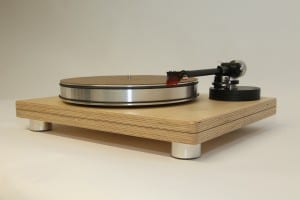 with the whole vinyl thing and had been rather enjoying listening to music using a dedicated computer as the source. However, when I was initially asked to review the Analogue Works Turntable One I thought why the hell not…and I was glad I did. Tim at Analogue Works was keen to tell me on the phone that the turntable was based on Tom Fletcher designs and was getting rave reviews from users, but the proof of the pudding and all that…
with the whole vinyl thing and had been rather enjoying listening to music using a dedicated computer as the source. However, when I was initially asked to review the Analogue Works Turntable One I thought why the hell not…and I was glad I did. Tim at Analogue Works was keen to tell me on the phone that the turntable was based on Tom Fletcher designs and was getting rave reviews from users, but the proof of the pudding and all that…
Analogue Works make just three turntables (The Zero, The One and The Two) with the One costing £799, the Zero £649 and the Two £1599 and they sell direct to the public to keep the costs down to a minimum. The turntables are made exclusively in the UK!
The One comes in a choice of two plinth finishes, with the one supplied for review arriving in furniture grade plywood (a black laminated version is available for an extra £50) and very nice in a minimalist kind of way it is too. You can get the turntable supplied with a variety of armboards, but I use the Origin Live Silver tonearm and so a Rega board came packaged. Fitting the arm is a simple affair and the armboard is nicely made out of what appears to be black acrylic.
Packaging is really rather good giving a high end feel immediately and the instructions are 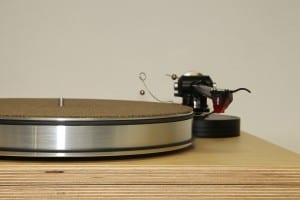 comprehensive yet very easy to follow. Set up is a piece of cake with the separate Premotec motor unit resting on whatever surface you put the turntable on and fitting through a cutout in the turntable at the back left. The cutout is ever so slightly oversized so that the motor can be positioned so that it doesn’t connect with the plinth in any way other than the belt!
comprehensive yet very easy to follow. Set up is a piece of cake with the separate Premotec motor unit resting on whatever surface you put the turntable on and fitting through a cutout in the turntable at the back left. The cutout is ever so slightly oversized so that the motor can be positioned so that it doesn’t connect with the plinth in any way other than the belt!
It is a belt drive tuntable unsurprisingly, offering both 33.33 and 45.11 RPM with the change being made with the accepted and widely used movement of the belt to a different “cog” on the motor. The low torque motor unit has a remote power supply box which can be sited away from the turntable itself which is a nice touch.
The platter is a hefty unit, weighs in at a not inconsiderable 6.7Kg and is made of an aluminium alloy. It looks rather pleasing set against the plywood I think and has a rubber “band” around it which I’d assumed was for dampening (more on this later) and tapping on the platter produces a solid thud rather than any ringing – this is a good sign! Supporting the platter is the bearing utilising a polished silver steel shaft with a precision ground nipple and a phosphor bronze sleeve with a hardened and polished roller… it’s a smooth as silk and the platter rotates perfectly.
You get a choice of mats to put on the platter, a thin rubber one, a foam one and one made from compressed cork so that you can play around and find the one that suits you best. I ended up using the rubber mat with the foam mat on top of that but the differences are marginal I’d suggest.
The One comes with three solid adjustable feet which make leveling of the turntable a much more simple process than those using four feet and you can add suspended feet for an extra cost, though I don’t think it’s necessary. All in all and even with cartridge alignment, you should be up and playing your favourite black discs in a matter of an hour or so…probably much less.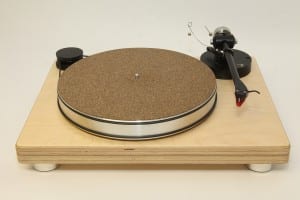
Throughout the review I used the Cartridge Man Music Maker III and the Origin Live Silver tonearm both of which I have used for a good while and know well. The photographs used in this review were supplied by Analogue Works.
On With Some Tunes
And first on the platter is a bit of reggae in the form of Dub Syndicate’s “Strike the Balance” LP. This is a good record to play to see what’s going on in the bass department and there are certainly no complaints from me here. Everything is tight and deep, with the flute on the song “Mafia” sounding correct pitch-wise and with no wobble suggesting that the speed is accurate and stable on this turntable. I don’t have a strobe disc to check this but I’d be very surprised if it’s not cock on!
A fairly hefty knuckle rap on the unit the turntable was sat on didn’t perceptibly travel through to the speakers (or headphones) and you can tap the actual plinth fairly hard before it’s picked up massively by the cartridge. This was a bit of a surprise to me if I can be frank – this is a very simple (but well engineered) turntable with no suspension or clever gizmos aboard, but it seems that plywood is actually a pretty sensible material to be used in turntables – I’m not sure we’d have seen the same result with a solid piece of MDF!
In the spaces between the tracks I couldn’t perceive any vibrations or noise coming from the motor and reaching the cartridge and it seems the simple method of isolating the motor from the plinth is effective as well as simply elegant.
Some guitar music to have another listen to the speed and next on the platter is Concierto de Aranjuez with John Zaradin plucking the strings. If speed is awry you’ll hear it on this record, but I have to say there’s nothing for me to moan about here! Guitar sounds like guitar and is pitch stable! Instruments are well separated in the stereo image and remain where they are supposed to.
Music has plenty of drive and, though it pains me to say it, I preferred the Analogue Works to my Wilson Benesch Circle as it just seems to connect you with the actual music in a much more organic and involving way. I even preferred it to my heavily modded Technics 1210 with the same arm and cartridge arrangement which is high praise indeed coming from me! The One has plenty boogie factor and the music bounces along really nicely and it’s a really addictive way to listen to your music.
The motor on this turntable is a low torque type that you have to spin above the desired speed and it them slows to the correct speed – this is what the rubber band around the platter is for I guess. Don’t spin the motor fast enough and it will run slow. I’m aware this is the nature of this kind of motor but I found this took a bit of getting used to, but it’s not an uncommon arrangement and you do get used to it after a few album sides.
I suppose this no nonsense motor arrangement is one area that costs have been kept low and it works perfectly well, but in these modern days of “give me convenience or give me death” this may be an irritation for some who would prefer an electronic speed shift. This is not to suggest the motor itself isn’t more than up to the job…it is (and then some) and my comment is more about convenience than anything else! Most audiophiles and music lovers should be more than happy to forgo this convenience for the sake of getting great sounds from their records.
As I said at the start of this review, the Analogue Works turntable arrived at a time when I was getting a bit jaded with the whole vinyl thing, but it’s had me reaching for album after album across loads of different genres which is a good sign – very often I find a bit of kit can often lean towards (be tuned for) a specific style of music – not so here and it will do banging techno just as well as it does folk or acoustic music! Despite its no nonsense looks and approach it does play music …and it plays music in a way that really gets under your skin to the point where you stop analysing what the turntable is adding or taking away and just get on listening to the tunes…and this is what the components in a hifi are supposed to do isn’t it? In fact I don’t think the turntable is actually adding very much to the mix at all!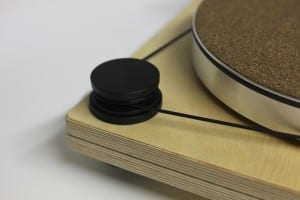
Ideally it should be placed on a wall shelf (sadly we’re having a move around and mine wasn’t available at the time of review) but the One is surprisingly unaffected by normal footfall. I did try placing the turntable and motor on an isolation platform, but found that this utterly ruined the coherence of the sound making it muddy and so when you go out and buy one of these stick with a solid surface rather than shelling out on fancy platforms!
Conclusion
This is a simple turntable that has been put together using high quality materials and components without frill or frippery and using solid engineering principles. It does its job of spinning the vinyl at the right speed very well and brings very little of its own flavour to the party.
I found myself putting down the tablet and computer files and delving into my record collection once again and, as I say, this is something I’ve not really done in a few months.
Overall, what I think you have with the Analogue Works One is a good looking, straight-forward and well engineered turntable that is sensibly priced (very sensibly priced and hence its high score).
With the cartridge and arm that I used (and I think they’re priced around the right price point to be the kind of things folk would use) you end up with a very capable analogue front end that just plays music for you and punches well above weight with regards its asking price. I’m certain that buyers could use a less expensive arm and cartridge combination on the One and still get very acceptable results, but I’d suggest it warrants spending the extra and it will take arms and cartridge combos even further up the ladder than mine I’m sure.
Regular readers will know that I always ask myself “Could I live with this?” and the answer here is a resounding yes, to the extent the WB Circle has gone to make way for this much less 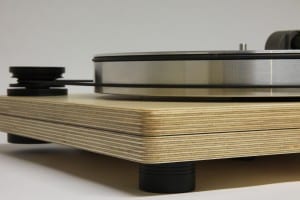 expensive model in the reference system.
expensive model in the reference system.
This is a very good turntable at a price that makes it something of a bargain and I think it fully deserves the scores I have given it!
Its solid and no frills approach will make it a turntable that should last you years and when you do want to upgrade I’d suggest you can do this by improving the arm and cartridge rather than needing to go out and buy a different turntable.
The Hifi Pig review process demands that this turntable now gets sent to a second reviewer, but had it been my decision I’d have awarded our Outstanding Product award independently.
Build quality: 9/10
Sound Quality: 8.5/10
Value For Money: 9.25/10
Recommended for people that want a simple to set up analogue front end that performs with exceptional musicality and at a price that makes it something of a bargain.
Stuart Smith








































































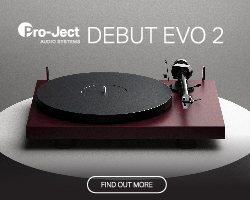


































































































































You must be logged in to leave a reply.